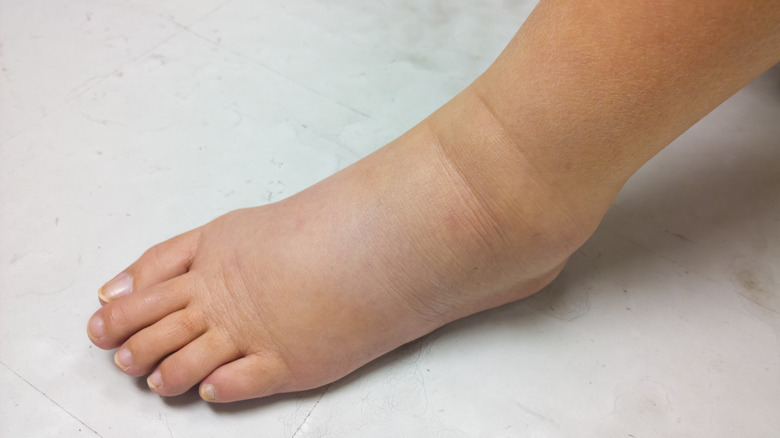What's The Difference Between Primary Lymphedema And Secondary Lymphedema?
The American Cancer Society defines lymphedema as swelling of the arms, legs, face, neck, abdomen, or genitals due to a build-up of lymph fluids in the body. The organization notes that lymphedema is progressive and often becomes a chronic condition.
Lymphedema can often be caused by cancer or a side effect of cancer treatment (via Centers for Disease Control and Prevention). According to the American Society of Clinical Oncology, lymphedema is the most problematic complication of breast cancer treatment affecting up to about 83% of on-treatment breast cancer patients. Johns Hopkins Medicine notes that lymphedema may occur even years after a breast cancer patient has gone off treatment. And while there's no cure for lymphedema, various treatment options can help manage the symptoms.
The causes of lymphedema vary, and clinicians categorize them into two types — primary and secondary. Continue reading to understand the differences between primary lymphedema and secondary lymphedema.
What is the difference between primary and secondary lymphedema?
According to Mayo Clinic, factors like older age, obesity, and rheumatoid or psoriatic arthritis can increase the risk of lymphedema. However, some people can develop this condition through genetic mutations, per WebMD. Cleveland Clinic explains that primary lymphedema is often hereditary and rare, affecting 1 in every 100,000 people in the United States. It results from an abnormal functioning or development of the lymphatic system, which doctors often diagnose through the clinical presentation, genetic analysis, structural imaging, or functionality of the lymphatics (via Nature Reviews Disease Primers).
The National Organization for Rare Disorders outlines three forms of primary lymphedema based on the condition's age of onset. The first is type I, which is congenital or shows in children up to 2 years of age. Type II affects people from 2 to 35 years old. Type III, known as lymphedema tarda, usually affects people 35 years and above. The organization adds that symptoms and severity vary from one primary lymphedema type to the other.
Unlike primary lymphedema, which is hereditary, secondary lymphedema results from an external cause, which could be infection, injury, trauma, or cancer, according to Medical News Today. These factors can be unintentional. Doctors try to limit the potential damage to your lymphatic system during cancer surgery, but this is rarely possible.
Lymphedema symptoms and treatment options
A 1998 study published in the journal Human Molecular Genetics notes that primary lymphedema is characterized by disabling and disfiguring swelling of the extremities. This swelling, which worsens over time, can show in a victim's limbs with varying degrees of inflation. Mayo Clinic adds that lymphedema, which leads to the inflammation of your lymph nodes, can affect mobility and lead to skin infections and sepsis. It advises patients not to hesitate to consult a health expert if common lymphedema symptoms like a feeling of heaviness and swelling of the arm, leg, fingers, or toes begin to show.
A 2022 study published in the journal StatPearls defines lymphedema as a progressive medical condition. So, seeking early diagnosis and treatment can't be overemphasized. The source adds that treatment options can include lymphatic venous anastomosis, which improves physiological drainage of the lymphatic fluid, or a suction-assisted protein lipectomy which removes lymphatic solids and fatty deposits causing inflammation. The latter works best for patients with later stages of lymphedema, while the former is effective during the condition's early stages.



